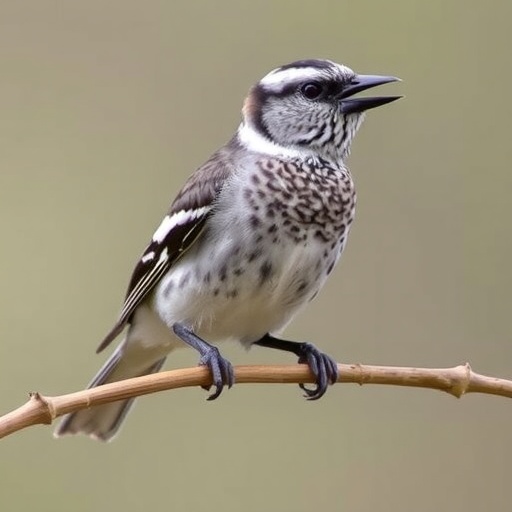In a groundbreaking study published in Science, researchers have unveiled that zebra finches possess a sophisticated capacity to not only differentiate between the diverse vocalizations within their species but also to classify these calls according to their semantic meaning. This discovery challenges long-held assumptions about animal communication, revealing a level of cognitive processing in avian species that aligns more closely with semantic perception than previously documented.
Zebra finches, small, vocal passerines native to Australia, have been the subject of intense ethological research due to their intricate social behaviors and repertoire of vocal signals. Unlike many animals that rely on simple, stereotypical calls, zebra finches employ approximately eleven distinct call types, each associated with particular social or environmental contexts. Until now, it remained uncertain whether these calls constituted mere acoustic signals or if they held intrinsic, categorized meanings comprehensible to the birds themselves.
The team led by Julie Elie designed an innovative experimental framework to directly probe the finches’ perceptual and cognitive abilities in relation to their vocal repertoire. A cohort of twelve adult finches was trained to recognize and respond to a single rewarded call type among a set of ten others, including calls from unfamiliar bird species, to assess the precision and boundaries of their auditory discrimination. This paradigm allowed for rigorous testing of the birds’ capacity to not only detect differences but also to mentally categorize sounds in a context-dependent fashion.
Results of the experiments demonstrated that zebra finches could accurately discern each call type within their communicative range. More profoundly, the pattern of errors—where misclassifications occurred—was revealing. When mistakes were made, they tended to happen between calls sharing similar social or behavioral functions rather than random errors across the acoustic spectrum. This indicates that the finches did not classify calls solely on physical sound properties but grouped them semantically, creating mental representations aligned with the meaning or purpose of each vocalization.
This semantic organization implies a hierarchically structured understanding of communication in zebra finches, where vocalizations are not merely sounds but cognitively mapped signals with associated relevance. The study challenges the reductionist view that animal calls are simple stimulus-response triggers and suggests the presence of an intermediate level of symbolic processing more advanced than mere conditioned reactions.
Understanding this semantic perception has significant implications for the field of animal cognition and communication. It expands the possibility that complex vocal understanding, a trait often linked uniquely with human language, might be present in smaller-brained species that communicate socially. Zebra finches thus emerge as powerful models for studying the evolution of linguistic faculties and the neural substrates underpinning semantic processing.
From a neurobiological perspective, the capacity to classify calls semantically hints at sophisticated auditory processing pathways and associative learning mechanisms within the avian brain. Prior work has established parallels between bird and mammalian neural circuits responsible for vocal learning, but this study adds a new dimension by linking perceptual discrimination with meaning-based categorization.
Moreover, the semantic grouping of calls reflects adaptive social cognition, crucial for survival in the birds’ natural habitats. Effective communication about threats, social bonding, mating readiness, and environmental cues depends on such accurate semantic understanding. Misinterpretation could have detrimental consequences; thus, the finches’ ability to map sounds to meanings optimizes group interactions and ecological responsiveness.
Methodologically, the study’s approach combining controlled behavioral experiments with species-specific vocal repertoires sets a benchmark for future research in animal linguistics. The use of rewarded call types as a discrimination task provides a robust framework to dissect perceptual categories from mere acoustic similarity. Further investigation into how these mental representations form during development and how plastic they remain throughout the birds’ lives will be indispensable.
This finding also opens avenues for comparative analyses across other social animals that employ rich vocal repertoires, such as primates, cetaceans, and certain rodent species. Understanding shared or divergent mechanisms of semantic perception could illuminate convergent evolution in animal communication systems.
Importantly, the study underscores the necessity of interpreting animal vocalizations through the lens of the animals’ own behavioral ecology and cognition rather than through human-imposed auditory categories. Calls that sound similar to human ears might hold distinct contextual meanings for the animals, a nuance elucidated by Elie and colleagues’ meticulous experimentation.
In conclusion, the revelation that zebra finches possess categorical and semantic perception of their call types advances the frontier of animal cognitive science. It portrays these diminutive songbirds as more than mere singers of instinctual tunes, but as creatures capable of nuanced understanding and mental organization of their social world. As research continues, such insights may reshape how we comprehend the origins and evolution of communication across the animal kingdom.
Subject of Research: Semantic perception and categorization of vocalizations in zebra finches
Article Title: Categorical and semantic perception of the meaning of call types in zebra finches
News Publication Date: 18-Sep-2025
Web References: 10.1126/science.ads8482
Keywords: zebra finches, vocal communication, semantic perception, animal cognition, call categorization, auditory discrimination, social behavior, avian neuroscience




